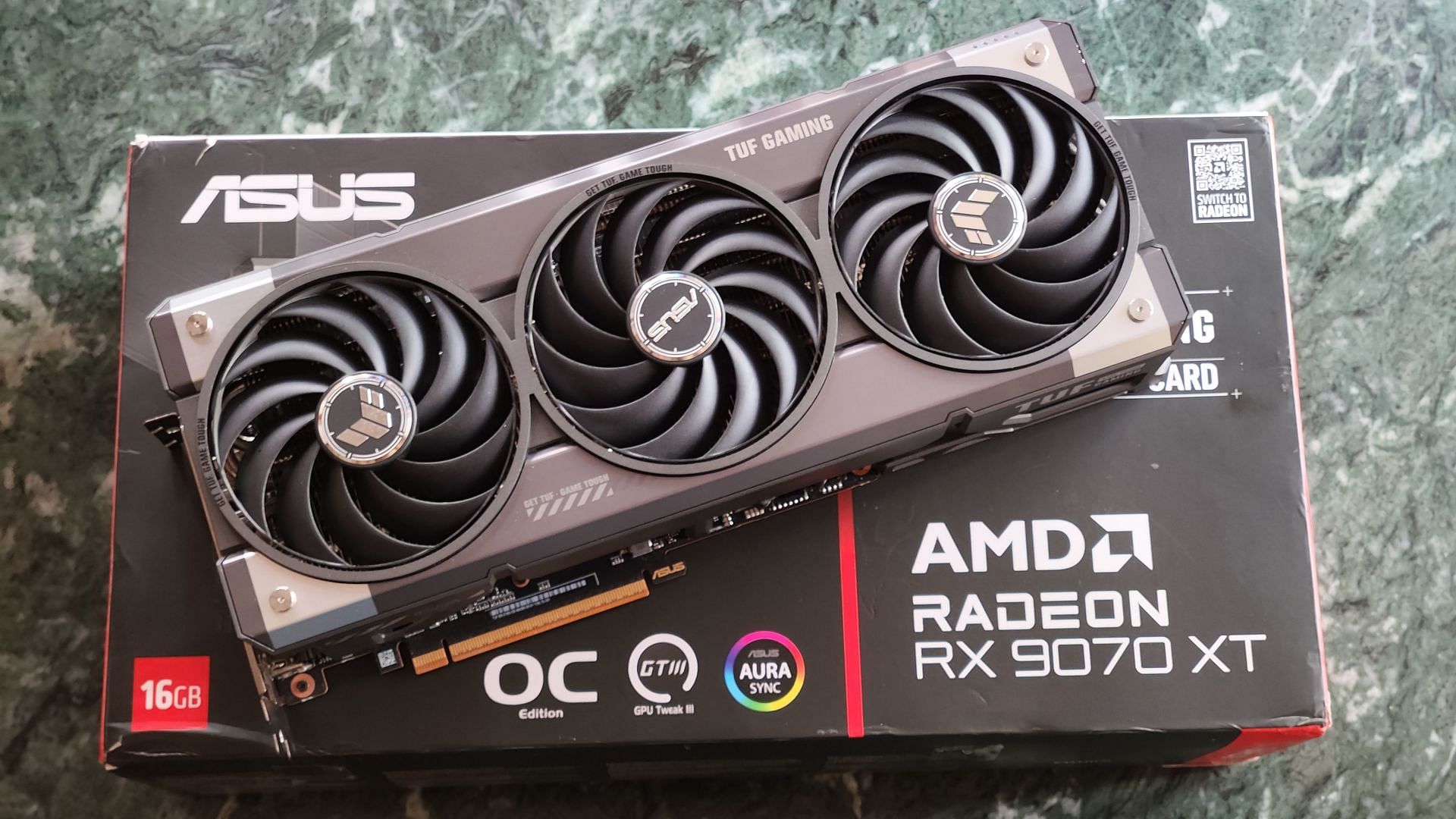The AMD Radeon RX 9070 XT is a high-end 1440p and 4K gaming GPU launched by Team Red to target the mid-range market. With a competitive price of $599, it is placed against the Nvidia RTX 5070, often offering better rasterization and ray tracing capabilities at native resolution. However, there are a few caveats, with AMD struggling to maintain MSRPs and stock, while lagging behind Nvidia in terms of upscaling techniques.
This raises the question — how good can the RX 9070 XT be for high-end gaming rigs? I got to spend a few weeks with the Asus TUF Gaming variant of the card. Read on to find out how it fares in a host of benchmarks and video games.
What are the specs of the AMD Radeon RX 9070 XT?


The RX 9070 XT is currently the flagship RDNA 4 offering from Team Red. The card is designed with specific cost-performance ratios in mind, with AMD bundling a host of techniques such as AFMF, anti-lag, and native overclocking to keep the card competitive against Nvidia.
For starters, you get the flagship Navi 48 GPU, which pairs 4,096 streaming processors. You get 64 Compute Units with improved ray tracing and improved AI accelerators. With RDNA 4, AMD has significantly improved its ray tracing formula, with performance almost at par with last-gen Nvidia video cards.
In terms of video memory, you get 16 GB GDDR6, similar to the cheaper Radeon RX 9070. For now, AMD hasn’t launched cards with larger video memory buffers; however, they might be headed to the market later this year.
The card is designed for 304W TDP, with recommended PSUs at 750W. This is sufficient for most gaming rigs in 2025, but the power requirements are a bit on the higher end.
Here’s the detailed specs list of the GPU:
For now, the card starts at $599, with high-end variants going up to $650. However, given the effect of tariffs and supply chain hiccups, you might not find many listings at the advertised price.
Read more: Nvidia RTX 4060 Ti review: Affordable ray tracing or expensive e-waste?
Test bench
The GPU was tested with a high-end Ryzen 9 9950X3D, representing the best all-AMD rig. We installed 32 GB of DDR5-6000 memory, with an X870 motherboard for Gen 5 capabilities. The details of the test bench are as follows:
- CPU: AMD Ryzen 9 9950X3D
- Motherboard: Asus Prime X870-P WiFi
- RAM: 2 x G.Skill Trident Z DDR5-6000 16 GB
- Storage: 1 x Gigabyte Gen 4 NVMe 1 TB, 1 x Patriot P300 M.2 PCIe Gen 3 x 4 128GB
- Cooler: Cooler Master Atmos 240mm liquid cooler
- Storage: Cooler Master MWE 1050W 80+ Gold
- GPU: ASUS TUF Gaming RX 9070 XT 16 GB
Synthetic benchmarks


For starters, we started with a DirectX 11 test, 3DMark Fire Strike. The RX 9070 XT fared pretty well in this benchmark, with scores better than the last-gen $999 flagship, the RX 7900 XTX. The card still lags behind the RTX 5080, albeit by a slim margin.
Next up, we tested 3DMark Time Spy, a DirectX 12 benchmark. Given this newer and more contemporary API, we expect more nuanced manifestations of the differences in rendering capabilities. The 9070 XT lagged behind the 7900 XTX by a considerable margin here, with scores slightly worse than the RTX 5090 laptop GPU.
Ray tracing hasn’t been AMD’s strongest suit for a few generations. However, with RDNA 4, Radeon cards have improved significantly. In 3DMark’s ray tracing test, the 9070 XT posts a 20% gain over the much beefier RX 7900 XTX from the last generation while also beating the RTX 4080 laptop GPU.
In 3DMark Steel Nomad, all of these gains consolidate for a total of 7,093 points, which makes the card faster than the 5080 laptop and much more capable than the RX 9070 16 GB. The GPU, however, trails the 5080 by a solid 15%.
Coming to real-time ray tracing tests, the RX 9070 XT shows similar gains as it beats both the RTX 7900 XTX and the RTX 3080 Ti in 3DMark Port Royal. Although performance isn’t at par with Blackwell and Ada Lovelace GPUs, the 9070 XT holds its ground spectacularly well for a $600 GPU.
3DMark Speed Way is a DirectX 12 Ultimate benchmark designed for estimating performance in some of the latest video games. In this test, the 9070 XT edges out the 7900 XTX slightly but is significantly behind the high-end 5080.
Gaming benchmarks


AMD has designed the 9070 XT for gaming, and hence we expect it to perform pretty well in the latest titles. Our test bench comprises a wide variety of video games, from Counter-Strike 2 to Black Myth Wukong. Here’s framerate numbers logged in several graphics settings combinations:
The 9070 XT is a beast at native 1440p gaming. In 4K, the GPU can’t keep up as well; however, we got playable framerates throughout, even with ray tracing turned on, except for Spider-Man 2.
Frame generation does help performance significantly; however, support still remains limited as compared to Nvidia’s DLSS. Moreover, AMD’s path tracing capabilities still remain in the mud. Hopefully, more powerful RDNA 4 iterations will improve upon this.
For now, we only recommend the 9070 XT for high-end 1440p gaming. 4K isn’t its strongest suit, as evident.
Temperature and power draw characteristics


The TUF Gaming variant packs sufficient heatsink mass to keep the Radeon RX 9070 XT cool under peak load. We stressed the card with Furmark 2 at 1440p, which resulted in surprising findings.
The average GPU temperature hovered around 56°C, which is much better than what most high-end Nvidia cards achieve. The memory junction ran significantly hotter, with the GPU hotspot touching 97°C.
In terms of power draw, the 9070 XT isn’t very forgiving with its 304W rating. In our testing, the TGP hovered around 279W, with the board power starting at 330W. At the maximum, the card drew 450W momentarily, maxing out the PCIe power connections, before settling at 373W.
In gaming, the characteristics vary significantly. We tested this with Cyberpunk 2077 running at the highest settings at 4K, which limits CPU bottlenecks and puts significant rendering workload on the GPU.
Starting with temperatures, the card averaged around 50°C, with memory junction temperatures hovering around 90°C.
In terms of power draw, the card exhibited several spikes beyond its rated 304W while running Cyberpunk 2077. We recommend a maximum momentary spike of 618W, which maxes out all the x16 and 8-pin power connectors. This necessitates a high-end 750W+ power supply.
The card is quite demanding, especially when you’re playing GPU-heavy games at 4K. However, with a high-end power supply and a decent motherboard, you can maintain the GPU without issues.
Read more: Nvidia RTX 5080 review: Can AI replace gen-on-gen improvements?
Value and conclusion


Overall, the AMD Radeon RX 9070 XT is a capable video card for high-resolution gaming without major performance hiccups. However, it falters at 4K, especially when the games are extremely GPU heavy.
Given the $599 price tag, however, the performance feels justified given it beats the RTX 5070 at raw rasterization. In the mid-premium range, the card offers enough capabilities to handle the latest titles at the highest settings without performance hiccups. However, it definitely leaves something to be desired given it’s the highest-end entry from Team Red so far.
Edited by Abu Amjad Khan






